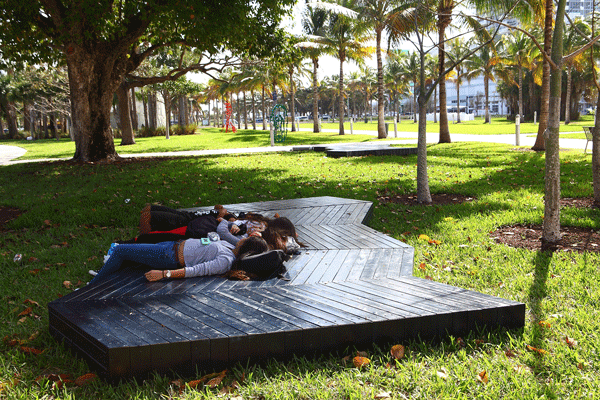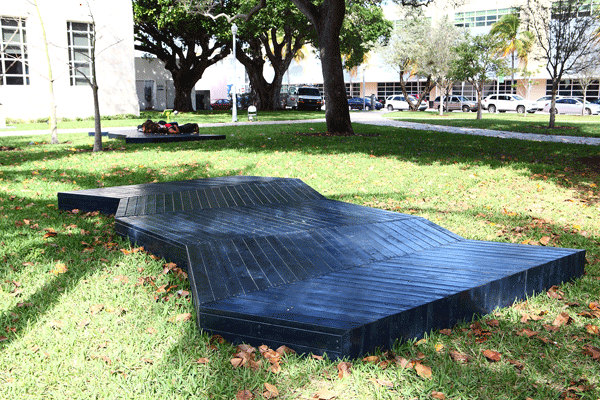
Points of Pine: inspired by Stella, produced by Moore, activated by you
By Elizabeth Shannon, Bass Museum of Art
Most artists are none too thrilled if you sit on their sculptures. However, Miami artist Emmett Moore is one of the exceptions. Moore’s Points of Pine (2014) is currently sited in Collins Park as part of the Bass Museum of Art’s tc: temporary contemporary program, and the work has hosted a great number of feet, backs and posteriors, just as the artist intended.
Emmett Moore, Points of Pine (2014) in use! Photo: Meg Pukel
Points of Pine developed from Moore’s observations of how Collins Park is utilized by the public. To compliment the park’s various well-used benches, the artist decided to create two free-standing platforms, with the idea of making (semi-)permanent ‘picnic blankets’ for visitors.
Moore based the design for his two decks on the American abstract painter Frank Stella’s shaped canvas Mas o Menos (More or Less) from 1964. You may be lucky enough to see this painting on view at the Pompidou Centre in Paris, if you happen to visit. One of Stella’s revolutionary series of ‘Black Paintings’, Mas o Menos is a monochrome, shaped canvas featuring painted bands which follow the configuration of the stretcher, creating a geometric design.
Moore identifieda number of correspondences between his practice as an artist and designer and Stella’s approach to the creation of his early work. Stella’s monochromes are often based on systems established by the artist’s choice of the tools and materials that are used inthe work’s construction: for example, he often used the standard width of a housepainter’s mass-produced brush to determine the breadth of a shaped canvas’s bands of paint. Moore used a similarly standardized, commonly available material to determine the scale of his work for Collins Park;the 2×4, one of the most common dimensions of lumber. The use of standardized materials meant that Moore was able create two decks that visually reference Minimalism and reflect how Stella’s works were conceived and produced.
Moore’s work in Collins Park riffs upon Stella’s interest in modular repetition through the presentation of two identical decks.Stella’s use of industrial paints to create his work also harmonizes with Moore’s interest in usingwidely available materials. Moore decided to paint his decks a rich blue, seemingly breaking with Stella’s preference for black. However, Moore’s use of blue refers to many artists’ use of highly-saturated dark blue pigment to give the impression of a deep black.
Moore’s final nod to Stella comes through the title given to his work, which references another of Stella’s ‘Black Paintings’, Point of Pines from 1959. Moore subtly tweaks the older artist’s title, calling his own work Points of Pine, reflecting the fact that his two decks are made of standard pine 2x4s and inhabit two separate points in the park.

Emmett Moore, Points of Pine (2014) installed in Collins Park. Photo: Meg Pukel
Stella’s ‘Black Paintings’ reinforced the Minimalist concept of the painting as a material object, as opposed to painting being required to represent something else (like a landscape or other subject matter), or being a personal expression, like the work of the Abstract Expressionists, against which Stella was reacting. Around the time that Stella created Mas o Menoshe was famously quoted as saying that a painting is “a flat surface with paint on it – nothing more.”
Moore pushes Stella’s idea of the painting as object even further into the realm of ‘objecthood’ by creating sculptural artworks that can be admired from an aesthetic viewpoint but which also have a utilitarian purpose: they can be sat on, slept on, or used for chatting and picnicking. I even once saw someone standing on one while wearing rollerblades – which I definitely do not recommend. Jim Drain’s soon-to-be-installed Chess Tables (2014) are also intended for public use, and like Moore’s Points of Pine, Drain’s two chess tables and accompanying chairs are simultaneously sculptural and utilitarian.
The signage for tc: temporary contemporary usually politely requests that the public do not touch or climb the works on display, but in the case of Points of Pine, we actively encourage physical engagement. Moore’s workexists at the intersection of painting and sculpture, but they are also a stage on which humans can interact.
Recent Content
-
Artsarticle ·
-
Artsarticle ·
-
Artsarticle ·
